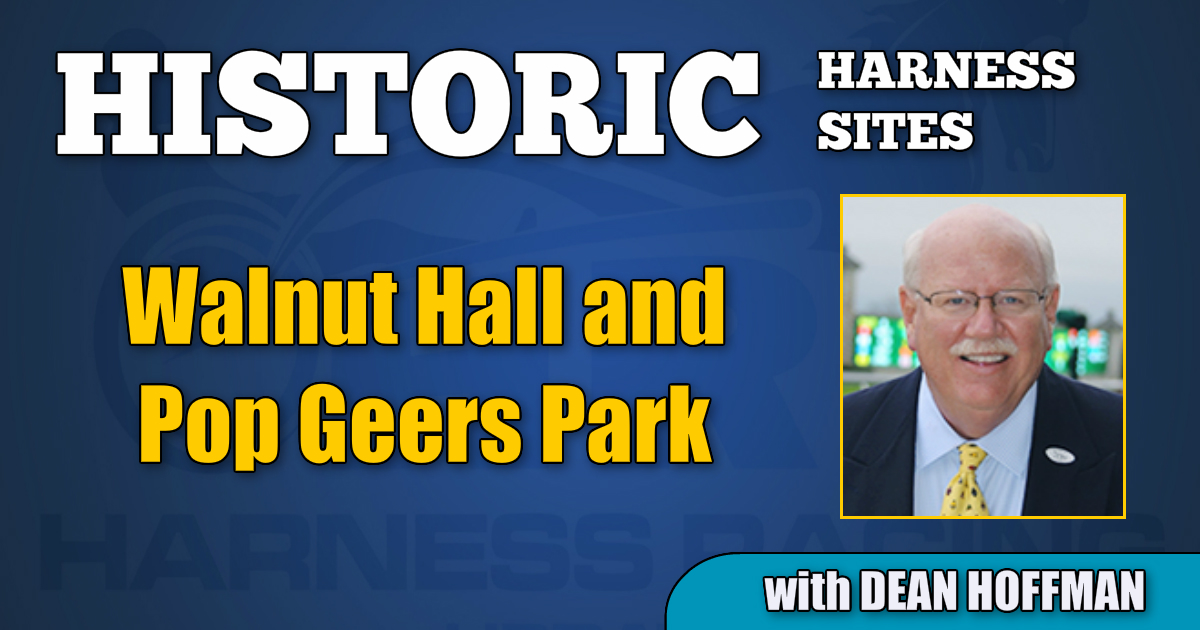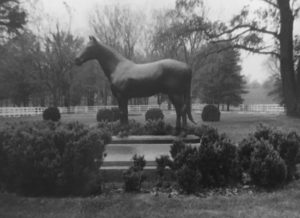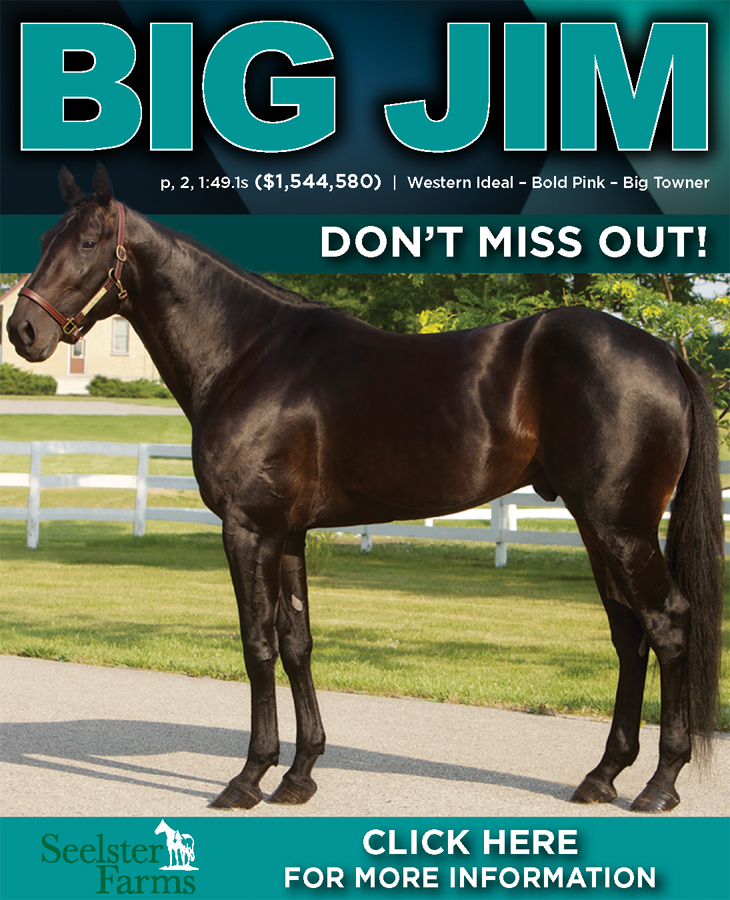

Remembering Walnut Hall Farm and Pop Geers Park
Part of a continuing series on historic locations in American harness racing.
by Dean A. Hoffman
Walnut Hall Farm, Lexington, KY
It is the grand dame of the Bluegrass trotting nurseries.
It covers a couple thousand acres of the best land in the Bluegrass for raising horses, and Walnut Hall Farm has sent forth stakes winners over a span of three centuries, starting when it was established in 1892.
The original Walnut Hall covered 4,000 acres, but over the decades the farm has been divided among the descendants of founder Lamon V. Harkness.
Today, Walnut Hall is divided, like Gaul of ancient lore, into three parts: Walnut Hall Stock Farm, Walnut Hall Ltd, and Dunroven Stud. They are owned, respectively, by Katherine N. Sautter, Meg Jewett Leavitt, and Martha N. Brown. The scale of the breeding operations is much reduced from the prime years in the first half of the 20thCentury when Walnut Hall Farm stood at the top of the sport.
It’s remarkable that Hanover Shoe Farms in Pennsylvania is approaching its centennial in less than a decade, but Walnut Hall Farm had been breeding champions for more than three decades before Hanover was established.
A walk in the stately Walnut Hall cemetery (now on property that is part of Walnut Hall Ltd.) gives you a full appreciation of this Bluegrass nursery’s impact. A statue of Guy Axworthy, one the great stallions of the early 20thcentury, stands sentinel over dozens of other immortals.
Not far from the Guy Axworthy rest the remains of Volomite and Scotland, two stallions that surged to the top of the stallion ranks after Guy Axworthy’s passing. Both Volomite and Scotland sired extreme speed and class on both gaits. The powerhouse pacing line of Somebeachsomewhere goes back to Volomite as do many trotting stalwarts. The trotting line of Valley Victory takes you directly back to Scotland.
It is altogether fitting and proper, to steal a phrase from native Kentuckian Abe Lincoln, that Guy Axworthy be honored with a statue at Walnut Hall. He came to the Bluegrass not long after it had been established and shot to the top of the ranks of trotting stallions.
Guy Axworthy was 24 years old when the first Hambletonian was contested, but his sons Guy McKinney and Guy Dean finished first and second. In the second Hambletonian, sons and daughters of Guy Axworthy swept the first three places, led by the filly Iosola’s Worthy. Guy Axworthy sired his final Hambletonian winner at age 28, and that colt Lord Jim won after his sire was resting in the Walnut Hall cemetery.
The year that Guy Axworthy sired Lord Jim, Walnut Hall got a new kid in the stallion barn, a 4-year-old named Volomite. He established himself immediately among the top stallions in the breed and reinforced that repeatedly over the next several decades.
Volomite was the most influential standardbred stallion of the 20thcentury because his prepotency allowed him to sire both trotters and pacers of extraordinary merit. His best trotters were the brothers Volo Song and Victory Song, Lusty Song, Worthy Boy, Kimberly Kid. Duke of Lullwater, Chestertown, and Scotch Rhythm.
The best pacers sent forth by Victory Song were the bothers King’s Counsel, Chief Counsel, and Blackstone — as well as Sampson Hanover, Goose Bay, White Mountain Boy.
Such trotting sires as the brothers Conway Hall, Andover Hall, and Angus Hall, Credit Winner and the extraordinary young sire Walner are others from the Volomite line.
A few years after Volomite took up residence in the historic stone stallion barn at Walnut Hall, he was joined by Scotland, a stallion that would leave his own remarkable impact on the breed. His best were theBorn To Trotfilly Rosalind and Hambletonian winners Hoot Mon and Spencer Scot.
Scotland sired a remarkable five Hambletonian winners and his son Hoot Mon sired a trio. But that branch of the Scotland line ultimately withered while the line from Spencer Scott-Rodney-Speedster is indeed vibrant.
For virtually two decades from the mid-1930s until the mid-1950s, trotting stakes were basically dominated by the get of Volomite and Scotland.
Walnut Hall also suffered its share of disasters. It invested heavily in the royally-bred stallion Algiers in the 1940s, only to see him flop badly. A decade later, the Nichols family went after the exciting young stallion Demon Hanover and paid dearly to acquire him, but Demon died after just a year at Walnut Hall.
In 1967, lightning struck a yearling barn at Walnut Hall, and 20 yearlings by such sires as Adios, Star’s Pride, Tar Heel and others perished.
In America’s Bicentennial year, Walnut Hall sold a yearling colt named Abercrombie for a modest price, then watched him become Horse of the Year in 1978 and later an incredibly influential stallion.
Like Old Man River, Walnut Hall keeps rolling on and its influence on harness racing is indeed enduring.
Pop Geers Park, Columbia, TN
How many city parks do you know that honor a harness horse trainer and driver?
None?
Think again because you’ll find Pop Geers Park in the heart of Columbia, Tennessee, a city in the southern part of the state also known as the home of President James K. Polk.
Alas, Edward F. Geers — known to all during his life as “Pop” — is virtually forgotten now, but he was a towering figure in harness racing for the first quarter of the 20thCentury.
He was a master trainer and driver, and his integrity and character were never questioned. He was revered by all in the sport.
Geers died as a result of injuries suffered in a racing accident at Wheeling, WV on Sept. 3, 1924.
Before the races that day, the Grand Old Man shook hands with a Pennsylvania lad whose grandfather brought him to see Geers and the trotters and pacers in action.
That youngster from Pennsylvania was Delvin Glenn Miller, and after he returned from military service in World War II, Miller vaulted to the pinnacle of his profession, gaining the same widespread admiration that Geers enjoyed in his lifetime.
Geers was known as “The Silent Man From Tennessee” because he preferred to let his horses do the talking on the track. He also was not the kind to criticize others in the sport. Much like Miller, Geers saw the good in people.
His integrity was unquestioned. It wasn’t unusual, even then, for race fixers to approach drivers to stiff a horse to cash a bet, but Geers gave them the cold shoulder.
“Temptation knocks unheeded at your door and hurries on to fields the promise more,” wrote harness racing’s poet laureate Walter Palmer in tribute to Geers.
Columbia is a city of 40,000 residents about 45 miles south of Nashville. Pop Geers Park is a tidy and nicely-landscaped urban haven with a granite spire that measures 45 feet. It was dedicated in 1926, two years after Geers died in West Virginia.
Although Geers was born in rural Wilson County in 1851, he came to call Columbia his home when he established his racing stable. His career on the track began in the high-wheel sulky era and evolved with the bicycle tire sulkies that came into vogue in the 1890s. Geers trained and drove countless stars, many of whom are long forgotten today, but his fastest horse was Napoleon Direct p, 1:59-3/4, a free-legged pacer that wore elbow boots. Napoleon Direct sired Billy Direct, whose 1938 time at Lexington gave harness racing its first 1:55 mile.
Speaking of Billy Direct, he was foaled just north of Columbia near the small community of Spring Hill, TN. There is an historical marker on the east side of US Rte. 31 which marks the farm where the champion pacer was born.
Drive a little further north on Rte. 31 and you will notice another historical marker, this one on the west side of Rte. 31. That honors the birthplace of Star Pointer, the first 2:00 pacer with his epic mile occurring in 1897.
Surely, few residents of Columbia today understand the significance of Pop Geers, but Tennessee was once a hotbed of harness racing and the Pop Geers Park is a worthwhile stop for anyone traveling in the mid-South.
In a poem written just before Geers’ death, Walter Palmer spoke for everyone in harness racing with these lines:
“May time and tide that do not wait Deal kindly with us here below But may they please just hesitate “Doggone it, Pop, we love you so.”

















